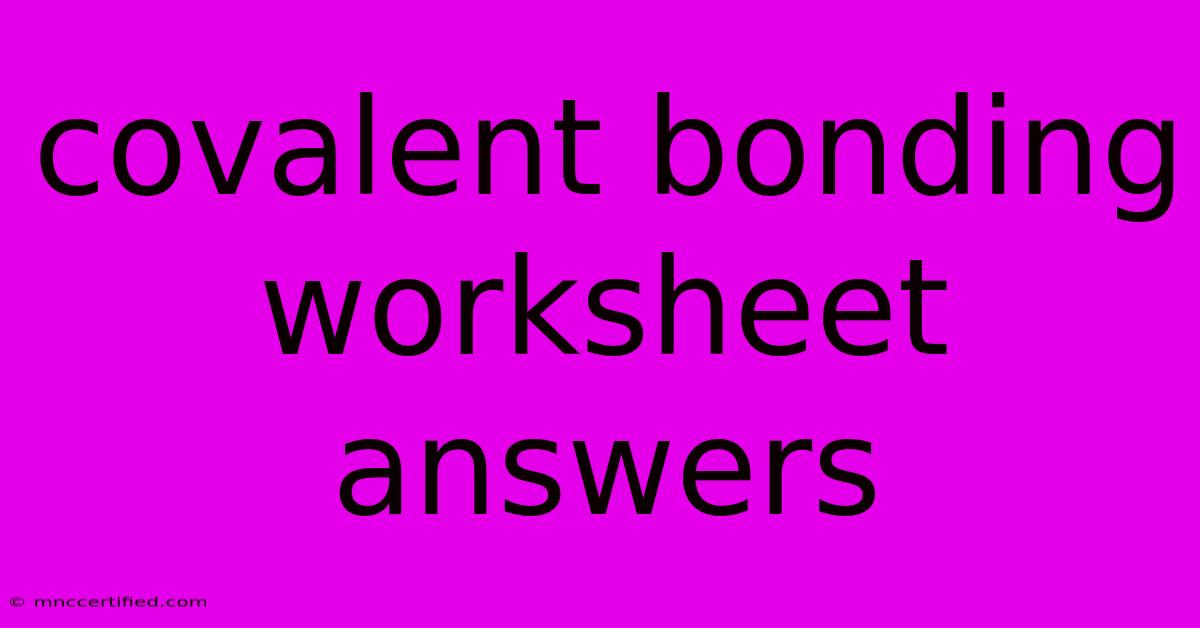Covalent Bonding Worksheet Answers

Table of Contents
Covalent Bonding Worksheet Answers: Mastering the Basics of Chemical Bonds
Covalent bonding is a fundamental concept in chemistry, explaining how atoms share electrons to form stable molecules. Understanding covalent bonding is crucial for comprehending the properties of countless compounds and reactions. To solidify your understanding, working through practice problems and checking your answers is essential.
This article provides a comprehensive guide to answering common covalent bonding worksheet questions, covering key concepts, examples, and helpful tips. Let's dive in!
Understanding Covalent Bonds: A Quick Recap
Before we jump into the answers, let's revisit the basics of covalent bonding:
- Sharing is Caring: Covalent bonds form when two or more non-metal atoms share electrons to achieve a stable electron configuration, resembling the noble gas configuration.
- Electron Pairs: Shared electrons form electron pairs, which are localized between the bonded atoms.
- Strong Attraction: The shared electron pairs create a strong electrostatic attraction between the positively charged nuclei and the negatively charged electrons, holding the atoms together.
Covalent Bonding Worksheet: Common Questions and Answers
Let's tackle some typical questions you might encounter in a covalent bonding worksheet:
1. Identifying Covalent Bonds:
Question: Which of the following pairs of elements would form a covalent bond?
Answer: Covalent bonds primarily occur between non-metals. Look for combinations like:
- Oxygen and Hydrogen: Forms water (H₂O)
- Carbon and Hydrogen: Forms methane (CH₄)
- Nitrogen and Oxygen: Forms nitrogen dioxide (NO₂)
2. Drawing Lewis Structures:
Question: Draw the Lewis structure for carbon dioxide (CO₂).
Answer:
- Step 1: Determine the total number of valence electrons for each atom: Carbon (4) + Oxygen (6) x 2 = 16 valence electrons.
- Step 2: Place the least electronegative atom (Carbon) in the center.
- Step 3: Place the oxygen atoms around the carbon atom.
- Step 4: Connect each atom with a single bond (two electrons).
- Step 5: Distribute the remaining valence electrons as lone pairs around each atom, ensuring each atom (except hydrogen) has an octet (8) electrons.
The Lewis Structure for CO₂:
O = C = O
3. Predicting Molecular Shapes:
Question: What is the molecular shape of methane (CH₄)?
Answer:
- Step 1: Determine the central atom (Carbon).
- Step 2: Count the number of electron groups (bond pairs and lone pairs) around the central atom: Methane has four bond pairs.
- Step 3: Apply the VSEPR theory to predict the molecular shape: Four electron groups around the central atom lead to a tetrahedral geometry.
4. Understanding Polarity:
Question: Is the bond between hydrogen and oxygen in water (H₂O) polar or nonpolar?
Answer:
- Step 1: Identify the electronegativity difference between the atoms. Oxygen is more electronegative than hydrogen.
- Step 2: A significant electronegativity difference (greater than 0.5) indicates a polar bond, where the electron pair is pulled closer to the more electronegative atom.
5. Naming Covalent Compounds:
Question: What is the name of the compound with the formula PCl₅?
Answer:
- Step 1: Identify the less electronegative element (Phosphorus) and name it first.
- Step 2: Use prefixes (mono, di, tri, tetra, penta) to indicate the number of each element's atoms.
- Step 3: Add the suffix "-ide" to the second element's name.
Therefore, PCl₅ is named Phosphorus Pentachloride.
Tips for Success on Covalent Bonding Worksheets
- Practice, Practice, Practice: The key to mastering covalent bonding is practice. Work through multiple examples and try different types of problems.
- Visualize the Structures: Drawing Lewis structures and visualizing the molecular shapes helps to solidify your understanding.
- Utilize Resources: Refer to your textbook, online tutorials, and study guides for further explanation and practice.
- Seek Help When Needed: Don't hesitate to ask your teacher or classmates for help when you encounter challenging questions.
Conclusion
Covalent bonding is a fundamental concept in chemistry that explains how atoms share electrons to form molecules. By working through practice problems and understanding the key concepts, you can confidently answer covalent bonding worksheet questions and develop a solid foundation in chemistry. Remember, practice makes perfect, and with persistence and effort, you'll master this essential topic!

Thank you for visiting our website wich cover about Covalent Bonding Worksheet Answers. We hope the information provided has been useful to you. Feel free to contact us if you have any questions or need further assistance. See you next time and dont miss to bookmark.
Featured Posts
-
Watch Eagles Vs Commanders Tv Schedule
Nov 15, 2024
-
Megyn Kelly Criticizes Snow White Star
Nov 15, 2024
-
Usa Vs Jamaica Lineup Notes And Analysis
Nov 15, 2024
-
Fbi Targets Polymarket Ceo In Nyc Apartment Raid
Nov 15, 2024
-
Infowars Sold To The Onion At Auction
Nov 15, 2024